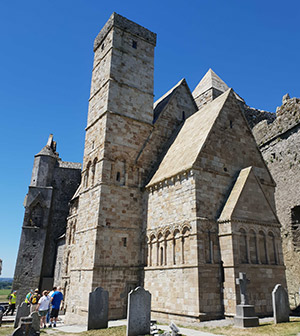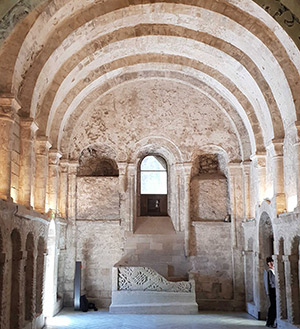Conservation works at Cormac’s Chapel
Published in Issue 5 (September/October 2018), News, Volume 26By Michele O’Dea

Above: Cormac’s Chapel—the only structure on the Rock constructed entirely of sandstone, with a massive high-pitched stone roof. (Barry Nangle/OPW)
Cormac’s Chapel is the only structure on the Rock constructed entirely of sandstone, a cream to buff-coloured coarsely grained sandstone, with a massive high-pitched stone roof. The chapel, probably one of the earliest Romanesque churches in Ireland, consists of a sophisticated display of string-courses and blind arcading on the internal and external walls, the multi-ordered doorways with carved tympana, the rib-vaulted interiors and the towers and spiral stairs.

Above: The rib-vaulted interior. (Barry Nangle/OPW)
The conservation work on these paintings was begun by the Perry Lithgow Partnership in 1986 and was completed in 1997; it consisted of the painstaking removal with scalpels of the numerous layers of extremely hard covering limewash that had calcified onto the surface. Following conservation, however, the sophisticated and complex original materials and techniques continued to be particularly vulnerable to the harsh environment in the exposed chapel, sitting high on the limestone bedrock outcrop at Cashel. In fact, the environmental conditions that posed a risk to the paintings continued to be a risk for the more durable stonework, as they were slowly but irrevocably eroding surfaces and removing the rich and ornate detail.
In 2002 a programme of research was initiated to establish the areas in which the building envelope was failing and to characterise the internal microclimate sufficiently accurately to allow it to be controlled. This involved a careful study of the building and the wall paintings themselves, including analysis of the plaster and painting materials and a long-term study of the environmental conditions. A roofed and enclosing scaffold was completed in 2010. Crucially, this allowed the building structure to dry out as well as providing an access scaffold for repair work to the masonry fabric. This was a highly complex operation, not only for structural reasons but also because of the very large volumes of rainwater that needed to be removed from the over-sailing roof of the scaffold.
The results formed the basis of the design for the repairs to the building envelope, in particular the sandstone roof, and the installation of rainwater goods to ensure that the building envelope functions correctly. The resulting reduction in the volume of water within the structure lowered the level of internal evaporation and brought the conditions within the building under control. This alone was insufficient to improve the conditions to the required level, however, and a system was designed to sample internal and external air and, when the external conditions were positive, to allow fans to operate, thereby ventilating the internal space with drier air from the outside.
Alongside the environmental controls, a programme of treatment of the biodeterioration was carried out using ultraviolet radiation of the type employed in water purification in order to reduce the level of microbiological growth on the internal architectural surfaces, including carvings and paintings. Conservation treatment of the paintings has also taken place throughout this period, and their condition has been carefully evaluated at regular intervals.
In combination with the repairs to the building envelope, the active environmental control has been successful in reducing and stabilising moisture levels, thereby reducing the level of damage and salt activity. The treatment of the microbiological growth has also been effective and the control of the environmental conditions has limited the extent to which it can easily re-establish itself to cause further damage.
Conservation of this type is not a one-off operation, and physical and environmental conditions will continue to be monitored in order to ensure that the architectural surfaces and paintings remain in good condition. Nevertheless, the work that has been undertaken over the last fifteen years has ensured that these unique and important paintings are now in better condition and are better protected than has been the case throughout their recent history. Employing both traditional and innovative methods as part of the conservation of the building and wall paintings, the project at Cormac’s Chapel can be considered to be one of the most advanced of its kind.
Michele O’Dea is Senior Architect, Conservation Services, Office of Public Works.
















